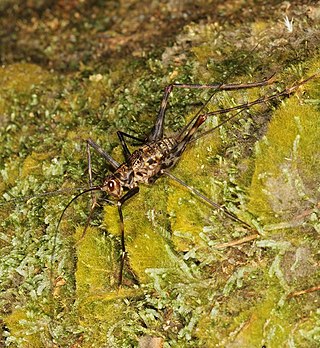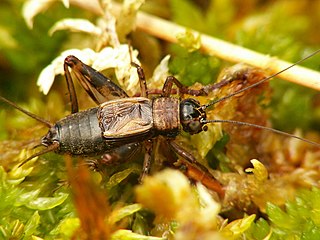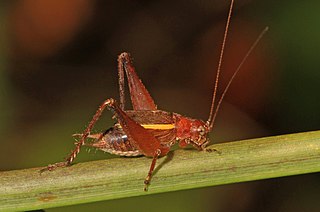
Anostostomatidae is a family of insects in the order Orthoptera, widely distributed in the southern hemisphere. It is named Mimnermidae or Henicidae in some taxonomies, and common names include king crickets in Australia and South Africa, and wētā in New Zealand. Prominent members include the Parktown prawn of South Africa, and the giant wētā of New Zealand.

Tree crickets are insects of the order Orthoptera. These crickets belong to the Oecanthinae one of the subfamilies of the recently (2022) restored family Oecanthidae.

Gryllacrididae are a family of non-jumping insects in the suborder Ensifera occurring worldwide, known commonly as leaf-rolling crickets or raspy crickets. The family historically has been broadly defined to include what are presently several other families, such as Stenopelmatidae and Rhaphidophoridae, now considered separate. As presently defined, the family contains two subfamilies: Gryllacridinae and Hyperbaeninae. They are commonly wingless and nocturnal. In the daytime, most species rest in shelters made from folded leaves sewn with silk. Some species use silk to burrow in sand, earth or wood. Raspy crickets evolved the ability to produce silk independently from other insects, but their silk has many convergent features to silkworm silk, being made of long, repetitive proteins with an extended beta-sheet structure.

Trigonidiinae is a subfamily of insects in the order Orthoptera, suborder Ensifera, based on the type genus Trigonidium. They are often referred to as sword-tail crickets, winged bush crickets or trigs.

The Phaneropterinae, the sickle-bearing bush crickets or leaf katydids, are a subfamily of insects within the family Tettigoniidae. They are also known as false katydids or round-headed katydids.

Phalangopsinae, occasionally known as spider crickets, are a subfamily of crickets in the family Phalangopsidae. Members of Phalangopsinae are found worldwide in tropical and subtropical regions. Most species in the subfamily are nocturnal and can be found in rocky areas, near fallen wood, and the understory of forests. Some species are gregarious, gathering in large numbers.

The Eneopterinae are a subfamily of crickets, in the family Gryllidae, based on the type genus Eneoptera. It is one of several groups widely described as "true crickets", but this subfamily may also referred to in American English as "bush crickets". Of the more than 500 species that make up this subfamily, most occur in moist, tropical habitats. These insects are medium to large and brown or gray in color. They eat plant leaves, flowers, and fruits and can occasionally cause economic damage. Their eggs are deposited in pith, bark, or wood. Eneopterinae show a great diversity in stridulatory apparatus, signals emitted, and associated behaviour.

Mogoplistidae is a family of scaly crickets within the superfamily Grylloidea. Considered to be monophyletic, a sister taxon to the Gryllidae crickets. This family consists of more than 370 species worldwide; 20 species in 4 genera occur in North America and this family includes the scaly crickets of Europe.

Grylloidea is the superfamily of insects, in the order Orthoptera, known as crickets. It includes the "true crickets", scaly crickets, wood crickets and other families, some only known from fossils.

Nemobiinae is a subfamily of the newly constituted Trigonidiidae, one of the cricket families. The type genus is Nemobius, which includes the wood cricket, but members of this subfamily may also be known as ground crickets or "pygmy field crickets".

Homoeogryllus is a genus of cricket in the subfamily Cachoplistinae and tribe Homoeogryllini. The recorded distribution is: Africa and Peninsular Malaysia.

The Hapithidi, previously placed as subfamily Hapithinae, is a supertribe of crickets in the family Oecanthidae and subfamily Podoscirtinae. It is one of several groups referred to in American English as "bush crickets", although this term can be confused with the Tettigoniidae.

Gryllidea is an infraorder that includes crickets and similar insects in the order Orthoptera. There are two superfamilies, and more than 6,000 described species in Gryllidea.

Romaleinae is a subfamily of lubber grasshoppers in the family Romaleidae, found in North and South America. More than 60 genera and 260 described species are placed in the Romaleinae.

Podoscirtinae is a subfamily of crickets in the family Oecanthidae.

The Phalangopsidae, which includes the "spider crickets" and their allies, are a recently (2014) reconstituted family of crickets, based on the type genus PhalangopsisServille, 1831 from South America. Priority for family-group names based on this genus dates from Blanchard's "Phalangopsites".
The Phaloriinae is a subfamily of crickets of the family Phalangopsidae. Species are terrestrial and are distributed in: Africa, tropical Asia, Korea, Australia and the Pacific Islands.
The Landrevinae are a subfamily of crickets, in the family Gryllidae, based on the type genus Landreva. They are terrestrial, omnivorous and may be known as "bark crickets"; genera are distributed in: Central and South America, Africa, tropical Asia, Korea, Japan, Australia and the Pacific Islands.
Luzarinaeis a subfamily of crickets in the family Phalangopsidae.

The Tafaliscinae are a subfamily of mostly Neotropical crickets in the recently restored family Oecanthidae and based on the type genus TafaliscaWalker, 1869. They can be found in warmer parts of the Americas and there is a species record from Java.
















